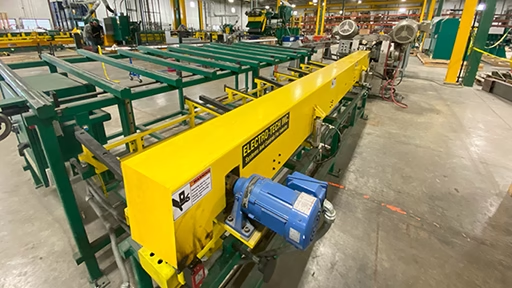For a long time now, companies have relied on bar straightening machines to remove bends and deformities from metal bars. Attempting to grind a bent bar can lead to several issues, including improper contact with the grinding wheel and regulating wheel. This can cause uneven grinding, vibrations, and even damage to the machine and workpiece. The bent bar may not be held securely or aligned properly, resulting in poor surface finish, out of spec tolerances, increased cycle time, and potential safety hazards. It is essential to inspect and straighten the bar before grinding to ensure accurate, safe, and efficient operation.
Bar straighteners utilize innovative technologies and techniques to straighten steel bars to the desired straightness with exceptional precision. The bar is carefully fed through the straightening machine, where a series of rollers, gears, and hydraulic systems work in harmony to correct any bends or deformities in the steel. The result is a perfectly straight bar that meets the most stringent quality standards.
Is it possible to automate a Bar Straightening Machine?
Yes, it is absolutely possible to automate bar straightening machines. This is commonly done to increase efficiency, consistency, and safety in industrial settings. In fact, current customers are achieving sub 10 second cycle times in full automation mode. Advanced automation can also include integration with upstream and downstream processes and sophisticated control systems that optimize straightening parameters for different bar materials and sizes.
Specifically, adding automated feeding and unloading to a bar straightening machine offers significant benefits:
> Increased throughput by reducing manual handling
> Improved safety by minimizing human interaction with moving machinery
> Enhanced consistency in positioning and handling
> Reduced labor costs.Automation streamlines the workflow, allowing for continuous operation and higher overall productivity compared to manual loading and unloading.
Metal processors in the know, understand the importance of utilizing advanced, precise heating and cooling techniques to ensures the bar achieves the desired straightness while maintaining its structural integrity and reducing the risk of residual stresses or defects. They are aware of how material-specific factors like yield strength, ductility, and elastic modulus determine how the material responds to applied stresses during straightening, and they employ different techniques for better results. They stay current with industry standards and best practices so they can optimize workflow efficiency and improve the consistency and quality of their straightening processes; all of which leads to reduced processing times, minimized material damage, and increased customer satisfaction. That’s why metal processors in the know turn to automation!
Integrating automation technologies such as CNC controls, bar feeder equipment, real-time monitoring systems, and automated calibration into your bar straightening process offers a significant leap forward in efficiency, precision, and safety. It reduces manual labor and ensures consistent quality enabling continuous, high-speed operation with minimal manual intervention. Automation streamlines workflows, minimizes errors, reduces waste, and increases throughput, ultimately leading to higher productivity, cost savings, improved quality and the ability to meet increasing demand while maintaining high standards of accuracy and surface finish — all key factors that provide optimal results that boost customer satisfaction.

